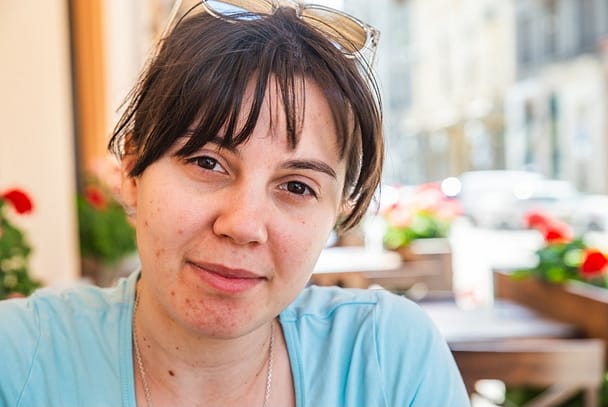Adult Acne & Hormone Signals
Acne is an affliction that is part of the course for most adolescents. During teenage years hormones are in upheaval in both sexes; the brain is signalling to the ovaries and testes that it’s time to switch on and become ready for reproduction.
This cacophony of hormone signals travel far (they are also responsible for feminising and masculinising our bodies) and have a large part to play in the state of our complexion.
Acne is most common on the face and neck and upper torso, including upper arms, chest and back. In teenage years affecting males and females equally. But once that’s all over and our bodies have developed into the fine men and women we are destined to be, the acne disappears? Right?
Unfortunately for many adults, acne is a very pesky but very normal problem. Hormones are responsible for adult acne, just like they are in adolescent years.
Adult Acne – An everyday foe
Both men and women can experience acne in adulthood, but it is far more common in women, with around half of women reporting adult acne. In the majority of cases, women experience a continuation of acne from their teenage years, known as persistent acne.
However, 1 in 5 women experience late-onset ‘adult’ acne which crops up >25 years of age, despite having clear skin when younger. Some women also experience atypical acne outbreaks around the onset of menopause (aka peri-menopause).
What causes Acne?
- Testosterone stimulates the production of sebum, an oily substance secreted from the sebaceous glands located under the skin. This is what gives skin that greasy, oily feeling.
- Dead skin cells accumulate and get stuck in oily pores rather than being shed off, clogging up the pore.
- Clogged pores can then be infected by the bacterium Propionbacterium acnes, which live on the skin surface.
- Once the bacteria invade the clogged pore they start to multiply; this triggers the immune system to launch an inflammatory response.
- This inflammatory response results in often unwieldy red and painful pimples appearing on the surface of the skin.
Who is most likely to get Adult Acne?
Androgens are the main acne-inducing culprit. Women produce small amounts of testosterone from the ovaries, and large amounts of DHEA from the adrenal glands (needed to make testosterone). The sebaceous glands themselves also convert steroid hormones into potent forms of testosterone.
In women predisposed to acne, other triggers may include stress and possible related high cortisol, poor diet and smoking.
Lots of ostensibly healthy women experience acne well into their 30s and 40s without any outwardly reason. Indeed, some women are simply predisposed to adult acne through their genetic make-up, and it may be that their sisters and mothers experience similar skin conditions.
Some women may be more sensitive to androgens than others, so although androgen levels may be within ‘normal’ ranges, these women react more strongly.
Menstrual cycle stage
As if having your period is not enough to put up with, acne typically rears its ugly head around this time. Right before menstruation both progesterone and estrogen (estradiol) are at their lowest levels.
Androgens, which don’t fluctuate a huge amount during the menstrual cycle, are now proportionally higher compared to other stages of the cycle when estrogen/progesterone are dominant. This balance of hormones invites the perfect storm for acne.
Despite pregnancy providing a break from menstruating for 9 months, it does not always give the acne reprieve one would hope for. Many pregnant women, particularly in the first trimester, often experience bad acne outbreaks. The causes of this aren’t fully established; confusingly some women report improved skin during pregnancy.
Hormone disorders
Polycystic ovary syndrome (PCOS) is a reproductive disorder that affects ovarian function and is associated with a hormone imbalance. One of the major hallmarks of PCOS is elevated androgens (including testosterone and DHEA-S) and many women with PCOS experience severe acne.
PCOS is commonly linked to obesity, which can elevate androgen levels even further. Obesity lowers SHBG, a protein that binds to testosterone and keeps it biologically inactive, equaling higher ‘free’ bioavailable testosterone.
Notably, weight loss can help to ameliorate the symptoms of hormone-induced acne in women with (or without) PCOS.
Other, rarer disorders of the endocrine (hormone) system can be responsible for severe acne, such as adrenal gland or thyroid disorders.
Anabolic steroid use
This one is probably most relevant to the men amongst us. Testosterone is an anabolic steroid with very powerful effects. The use of testosterone therapy (gels, creams, patches, injections) or even testosterone-boosters (remedies to increase natural testosterone production) can elevate testosterone levels beyond normal ranges (especially in men who are not testosterone deficient to begin with).
Men raising their testosterone levels through supplementation commonly report increased body acne.
Hormone assessment
Understanding how your hormones are behaving and how they are in balance with one another may help pinpoint why acne is reoccurring or flaring up at certain times.
For example, if you think that your acne may be related to the onset of menopause, in which estradiol and progesterone levels decline, try the Female Active Hormones Test. This test specifically measures Estradiol [E2], DHEAs, Progesterone, Testosterone [Includes Progesterone/Estradiol ratio] which are hormones that can affect the health of our skin.
Living with Acne
Acne, particularly severe acne, is frustrating to live with; it is visible to the world and hard to cover-up. Research looking at quality of life measures show that acne in women negatively affects self-confidence and can lead to depression.
The psychological symptoms are further impacted by the physical scarring that can occur on the skin, making adult acne a really pressing health issue.
Unfortunately, there is no quick way to treat acne. If acne is a problem and affecting your physical and mental well-being, seek help from a dermatologist.
Prescribed Treatments
For women not wishing to conceive, the contraceptive pill is a common choice to help alleviate acne. Oral combination pills that contain estrogen and progestin (synthetic form of progesterone) are particularly effective as they inhibit the production of androgens, lowering testosterone levels.
Other treatments that a doctor or dermatologist may prescribe are antiandrogen drugs, topical creams or antibiotics.
Diet – What types of Foods cause Acne?
The jury is still out over which type of foods worsen acne. The good news is that there is little evidence that chocolate causes acne, however it is probable that a diet high in sugars and dairy (high glycaemic) is not good for the complexion, particularly if already prone to acne.
The data on diet and acne is limited and an area where more research is needed, however combining acne treatments with a low glycaemic diet could be beneficial.
Skin care and Acne – What’s the Advice?
The advice is that less is more. Don’t give in to the urge to buy expensive skin care products that claim to work miracles (some promise by the next day!). Adult acne is invariably caused by hormonal and/or genetic causes and skincare products are not going to provide a cure.
That said, selecting non-comedogenic cosmetics, oil-free moisturisers and a dermatologist-recommended face wash or cleanser, could help prevent current acne getting worse.
I hope you enjoyed reading this short informative post. You’ll find others in our Blog.
Author: Guy Saywell
TestoChecker Hormone Test Kits ®
Phone: +61293271336
Address: Suite 1A, Level 2, 802 Pacific Highway,
Gordon, NSW, 2072.
Sources:
- Ju Q, Tao T, Hu T, et al. (2017) Sex hormones and acne. Clinics in Dermatology 35:130–7.
- Romańska-Gocka K, Woźniak M, Kaczmarek-Skamira E, & Zegarska B. (2016). The possible role of diet in the pathogenesis of adult female acne. Advances in Dermatology and Allergology 33(6), 416–420.
- Tanghetti EA, Kawata AK., Daniels SR, et al. (2014). Understanding the Burden of Adult Female Acne.The Journal of Clinical and Aesthetic Dermatology, 7(2), 22–30.
- Zeichner JA, Baldwin HE, Cook-Bolden FE, et al. (2017). Emerging Issues in Adult Female Acne.The Journal of Clinical and Aesthetic Dermatology, 10(1), 37–46.
-

Adrenal Function Extended Profile Test Kit
Salivary adrenal-cortex assessment. DHEA's x 1 + Cortisol x 4. View Sample Report.$207.90Read More -

Fertility Balance G2 Hormone Test (Basic)
DHEAs, Estrogen [E2], Testosterone, Progesterone. Includes Estrogen/Progesterone ratios.$163.90Read More -

Melatonin Sleep Rhythm Test Kit
Melatonin hormone test (X2) 12AM and 6AM.$140.80Read More



